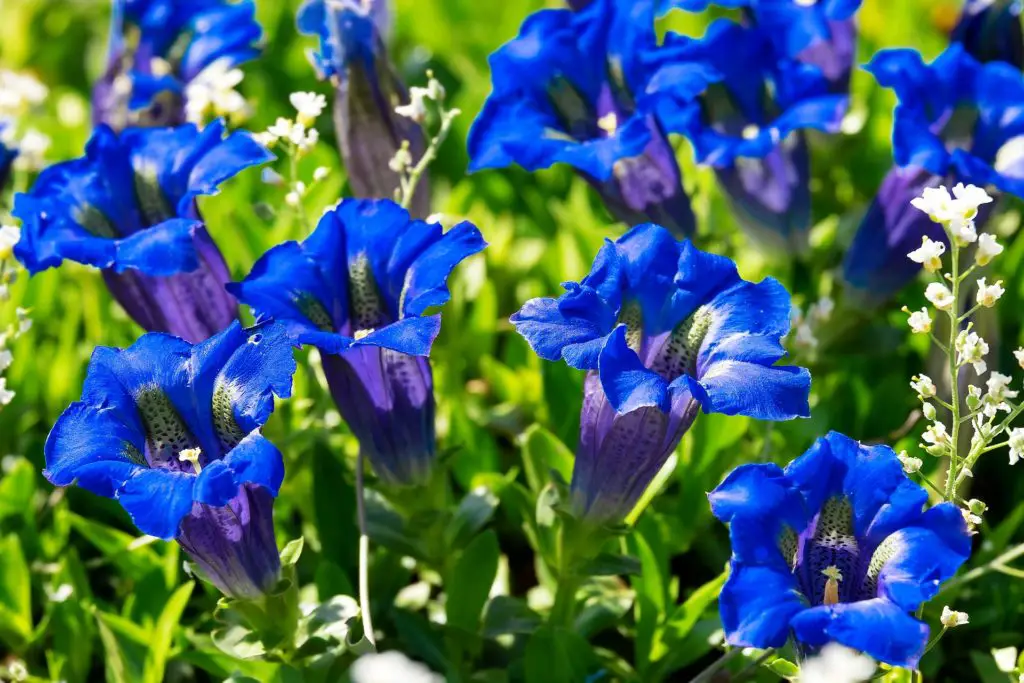Gentian Biological sources, Morphology, Chemical Constituents, Adulterants and Uses + MCQ (10)
Gentian
Synonyms:-
Gentian root, Gentiana, Radix Gentianae.
Biological source:-
Gentian consists of the dried fermented roots and rhizomes of Gentiana lutea, the yellow gentian.
Family:- Gentianaceae.
Geographical source:-
Gentian is indigenous to hilly areas in Southern and Central Europe (like Jura, Vosges mountains), Yugoslavia and Turkey.

Collection and Preparation:-
It is a perennial herbaceous tree and when the plants are 2 to 5 yrs old the turf i.e. a surface layer of earth containing grass plant with their matted root is carefully stripped off. The rhizomes and roots are dug up. This usually takes place from May to October. Collection in the autumn being more difficult because hardness of the soil but preferable from the medicinal point of view. At this stage the pieces of roots and rhizomes are white in colour without any odour which is unfermented gentian and have no demand in market. Then the drug is made into heaps which are allowed to lie on the hill side for some time and may even be covered with earth. After it is washed and cut into suitable length, the drug is dried first in the open air and then in shades. Prepared in this way the drug became much darker in colour loses some of its bitterness and acquires a very distinctive odour
Macroscopic Character:-
Colour: Rhizomes are yellowish brown.
Odour: Special odour.
Taste: Sweet taste followed by intensely bitter taste.
Shape: Cylindrical rhizome.
Size: Diameter is about 4 cm and more than 1m in length.
Fracture: Brittle, tough.
Chemical Constituents:-
- Gentian contains bitter glycosides, alkaloids, yellow colouring matters, sugars, pectin and fixed oil.
- The bitter glycosides mainly contain gentiopicrin (also called gentiopicroside) which is water soluble crystalline compound with bitter value of 12,000. During fermentation and drying, it breaks down into gentiogenin and glucose.
- A biphenolic acid ester of gentiopicroside, amarogentin which occur in small amount (0.025-0.05 percent) has a bitterness value some 5000 times greater than that of gentiopicroside and is therefore an important constituent of the root.
- Other bitters isolated are sweroside and swertiamarin. The yellow colour of fermented gentian root is due to xanthones and gentisin (also known as gentiamarin) isogentisin and gentioside. Gentian also contains gentisic acid and about 0.03 percent of the alkaloids gentianine and gentialutine.
- Gentian is rich in sugars which include the trisaccharide gentianose, the disaccharide gentiabiose and sucrose which on fermentation can convert on glucose and fructose and for very long fermentation can convert into alcohol and CO2.
Chemical test:-
The extract shows blue fluorescence under UV light.
Uses :-
Bitter tonic, stimulates gastric secretion, appetite enhancer. Gentian is used in herbal medicines for digestive problems, fever, hypertension, muscle spasm, parasitic worms,wounds, cancer, sinusitis, and malaria.
Adulterant and Substituent:-
1. Rhizome of Rumex alpines
2. Veratrum album,
3. Gentiana purpurea
4. Gentiana pannonica
MCQ
1. Which of the following is not adulterant of gentian ?
A. Gentiana Purpurea
B. Gentiana Pannonica
C. Radix
D. Veratrum album
2. Gentian is belong to family
A. Combretaceae
B. Liliaceae
C. Solanaceae
D. Gentianaceae
3. Match Of The Following
i. Biphenolic acid ester A. Gentianose
ii Bitter Glycoside. B. Gentiabiose
iii Trisaccharide. C. Gentiopicroside
iv. Disaccharide. D. Gentiopicrin
A. i→D ii→C iii →B iv→ A
B.i→C ii→D iii →A iv→B
C.i→B ii→A iii →C iv→D
D.i→ A ii→ B iii→C iv→D
4. Which of the following is False about Gentian ?
A. Gentian is cultivated in South and Central Europe.
B. Gentian Rhizome has yellow colour.
C. Gentiopicrin has bitter value 12,000.
D. On hydrolysis of gentiopicrin it is produces Gentiopicroside.
5. Which of the following is true about Gentian ?
A. Gentian rhizome are 2 cm in diameter and 3 cm long.
B. It is sweet in taste.
C. It has smooth fracture.
D. Rhizome has yellow colour.
6. The yellow colour of fermented gentian root is due to
A. Xanthoses
B. Gentisin
C. A and B
D. None of the above
7. Which is measured Chemical Constitution Of Gentian ?
A. Gentiopicrin
B. Gentiopicroside
C. Gentianose
D. Gentiabiose
8. Gentian Chemical Test is
A. Blue fluorescence under uv light
B. Yellow fluorescence under uv light
C. Green fluorescence under uv light
D. Red fluorescence under uv light
9. Which is not use of Gentian ?
A. Bitter Tonic
B. Appetite enhancer
C. Hypertension
D. Hypotension
10. Which of the false macroscopic Characteristics of Gentian ?
A. The rhizome are yellow colour.
B. It is bitter in taste.
C. Rhizome has Cylindrical shape.
D. The rhizome are Brown colour.
Participate in Online FREE GPAT TEST: CLICK HERE
Participate in Online FREE Pharmacist TEST: CLICK HERE
Participate in Online FREE Drug Inspector TEST: CLICK HERE
Participate in CSIR NET JRF Mock Test
Answer Key
1. C
2. D
3. B
4. D
5. D
6. C
7. A
8. A
9. D
10. D
Reference :-
16 Edition of Trease and Evans Pharmacognosy Text Book ( Pg. No. :- 333)